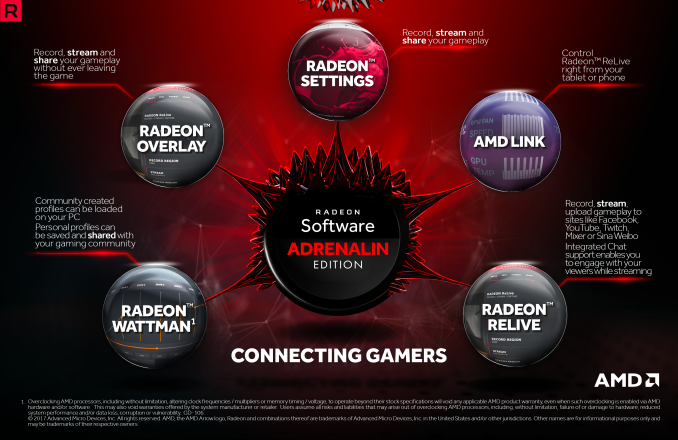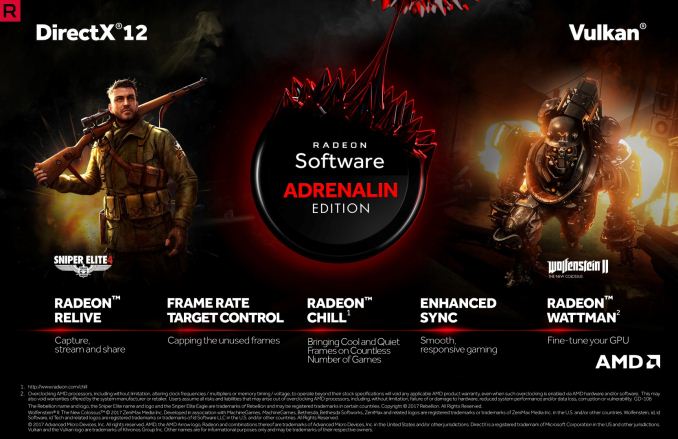AMD Releases Radeon Software Adrenalin Edition: Overlay, App & More for 2017
by Nate Oh on December 12, 2017 9:00 AM ESTFinal Thoughts
To preface, a list of resolved issues was not provided before today’s launch. Glancing over the release notes, a few snippets were not included in the presentations or press releases. FreeSync 2 display support for HDR10 titles is a notable one, considering that we have not heard much since the original announcement of the initiative. Other than the two Samsung monitors, we've only covered an AOC announcement on displays due in April 2018. And of course, the list of bug fixes include several resolutions that users have clamored for in the past couple months.
As for Adrenalin Edition proper, the streaming focus tends to take center stage with Radeon Overlay, AMD Link, and the ‘Connect Tab’. The community angle is more of an accessory to the streaming attributes.
The core features updates and Vulkan emphasis does make Adrenalin useful for general users, but the increased social focus and streaming/sharing integration brings GeForce Experience and ShadowPlay to mind. For streamers, the combination of AMD Link on a tablet/smartphone, Radeon Overlay, and ReLive Adrenalin seems like it could positively impact workflow, particularly if they are doing it casually.
In gauging AMD Link especially, there seems to be some reasonable use cases beyond streaming. For social gamers who want to send screenshots or instant replays of everything to everyone, AMD Link provides that quick option during a respawn timer or end-of-round. It also provides an easy way to post in-game videos or pictures to social media.
In most cases, users will have their phone nearby when on a desktop or laptop, and AMD Link can turn that into a ‘free screen’ for performance monitoring if desired. For laptops and similar situations where screen space is at a premium, this would be a good alternative to an OSD that would show up too small anyway. In all of those scenarios, though, the newsfeed seems superfluous.
Offhand, considering a Radeon Pro Software ReLive and hypothetical AMD Pro Link might have some interesting business functionality. But at the very least, AMD has come very far since even Raptr and Gaming Evolved, and at the same time cut down a few excess syllables to their display driver name.
For both Crimson ReLive and 17.7.2, we reiterated the importance of execution. With Adrenalin, AMD has made the UX much more consistent across different products and configurations. From last year, ReLive is continuing to accumulate better features and find a stronger niche with Radeon Overlay and AMD Link; though in practice this mostly depends on how streamers and social gamers take to it.
On the feature side, Adrenalin is another solid entry for AMD and RTG’s annual major updates. But AMD’s first high-end card launch in two years, especially one featuring a new forward-looking microarchitecture, is not irrelevant to even feature updates, and graphics software is not totally divorced from the hardware itself; a good UX at the least complements the hardware. Users are still inquiring about the RX Vega hardware features, which has affected their expectations of Adrenalin Edition and presumably their present response to it. Consumers still recognize that Adrenalin Edition is a driver that includes performance improvements.
The new Radeon Software Adrenalin Edition 17.12.1 drivers are available through the Radeon Settings tab or online at the AMD driver download page. More information on this update and further issues can be found in the Radeon Software Adrenalin Edition 17.12.1 release notes.



















42 Comments
View All Comments
lmcd - Tuesday, December 12, 2017 - link
Didn't realize how far AMD has gotten. Would've considered purchasing except for the unfortunate power draw.While multiple people are claiming that power draw should not be a consideration for me within the United States, heat is a consideration as to both the product's lifespan and its case compatibility. As someone happy with my Silverstone SG09 (except, maybe, that it's not an SG10), an ITX form factor GTX 1070 was the obvious choice. The Vega 56 does not have any ITX models, to my knowledge, and any such options would require liquid cooling and a custom PCB (well out of my price range).
B3an - Tuesday, December 12, 2017 - link
Wish Nvidia had those streaming features but i'm not downgrading to a less powerful GPU for them.FourEyedGeek - Thursday, December 14, 2017 - link
The bait was thrown out, 3 days later no one has still bitten.PeachNCream - Tuesday, December 12, 2017 - link
I'm not so sure about the names of these driver releases from AMD. We've had ReLive and Adrenalin so is Amygdala or Pituitary next and when will we start exploring other hormones and neurotransmitters?extide - Tuesday, December 12, 2017 - link
It's Adrenalin, not Adrenaline. Adrenalin is a flower.rocky12345 - Tuesday, December 12, 2017 - link
Nice write up on this thank youI kinda like the new look of the overlay and actually getting better support for a lot of the settings we need. The smartphone connect thing is also nice but myself and maybe a lot of other people already use the onscreen performance monitors provided through MSI Afterburner+Riva Tuner together. I also hope they do not break my Sapphire 390x tri-x card again like when the first Crimson driver release happened it took about a year to get that sorted out. Then again since most of this is just feature updates and not driver related us 290 & 390 series owners should be fine.
Good to see AMD actually adding features a lot of people want it is to bad there are no Vega updates mind you I am sure the Vega owners were looking forward to some AMD love on the Vega front.
deksman2 - Tuesday, December 12, 2017 - link
People... the reason Vega's power draw is a bit higher in relation to Nvidia is because AMD is forced to use a 14nm process designed for low power and low clocks - plus, it usually overvolts its GPU's for the sake of improving yields, and both Vega 56 and 64 have much higher amount of stream processors, which means they have higher compute capabilites - and guess what, that takes power.Obviously if you go past a certain limit in clocks, power draw skyrockets.
The new 12nm process Vega refresh will be made should get rid of that problem and allow Vega to clock much higher with lower power draw.
On the other hand, if you also undervolt Vega on stock clocks and even overclock it, you can get Vega 56 to behave like Vega 64 performance wise, while drawing LESS power than 1080.
On the other hand in games that are optimised for PC platforms, also ones using DX12 and Vulkan, Vega 56 and 64 generally beat their Nvidia counterparts at stock.
Vega 56 at 2k and 4k for example is equivalent to 1080, while 64 gets within 10% of 1080ti.
Undervolt them both, and you gain better efficiency (more so on Vega 56 than 64).
But, as I said, the 12nm LP should allow Vega to clock on both the core and HBM to higher levels while using less power, and ergo will perform a lot better.
The 12nm LP is a process which Nvidia will be using for transitioning from current 16nm process (designed for high clocks).
Plus, before he left AMD, Raja Koduri mentioned that Vega's Infinity Fabric was not optimised for games and that game optimised versions of Vega are coming (most likely on 12nm LP).
Gigaplex - Tuesday, December 12, 2017 - link
Why is AMD forced to use a lesser manufacturing process? Neither AMD nor NVIDIA own fabs, they both subcontract to the same fab companies.JasonMZW20 - Tuesday, December 12, 2017 - link
The 14nm LPP process node is a decent process and is efficient. If it wasn't, Ryzen would've been a disaster. Sure, it's not the best out there, but it is a refined Samsung node that GloFo licensed. 12nm (14nm+) might be tech they acquired from IBM. "12nm" isn't a cure-all for Vega though; large dies have notoriously poor yields and 12nm won't shrink the die size (does have improved density though). Sure, it'll allow slightly higher clocks within the current 295W TBP (345W for LC) or they can offer the same clocks with a lower 236/170W (64/56) TBP (Flat 25% power reduction from 295/210W). True 2Gbps HBM2 would help too, as HBM2 voltage spec is 1.200v, but Vega64 has to use 1.356v to overclock HBM to 945MHz (from 800MHz).Vega uses more power simply because of what you said: amount of shader processors and higher stock voltages than optimal. Ryzen and Vega are similar in that they're pushed a little bit past their efficiency point. I've achieved good efficiency by undervolting, but I've completely given up on OC because my Vega64s just aren't compliant without significantly raising voltage and spiking power draw for a few percentage points of increased processing power (and maybe 5fps for an extra 40W). I need over 1.150v just to get 1677MHz. I stick to about 1565-1605MHz at 1.018-1.025v with good overall performance and reduced power usage.
Keep Vega below 65C and you'll reduce chip leakage as well. I reduced power usage by 10-15W just by doing that on my air cooled cards (tested both with the same settings aside from temp target and 75C card consistently used 10-15W more with spikes up to 25W at times). 10-15W can get you a bit more headroom for GPU turbo.
Also, Infinity Fabric auto overclocks with memory speed. At/After 1115MHz HBM, IF domain overclocks to 1200MHz (from 1107MHz), which can slightly improve overall performance if you can get it stable (HBCC, especially).
mapesdhs - Thursday, December 14, 2017 - link
#include <rant.h>When did drivers start being given marketing product names as if they were physical things? At this rate driver releases are going to get "reviews" just like any other product, and they won't be free anymore.